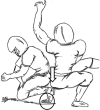Return to division ia football following a 1 metatarsophalangeal joint dorsal dislocation
- PMID: 21589669
- PMCID: PMC2971641
Return to division ia football following a 1 metatarsophalangeal joint dorsal dislocation
Abstract
BACKGROUND.: Although rare in occurrence, a dorsal dislocation of the 1st metatarsophalangeal (MTP) joint has been successfully treated using surgical and/or non-operative treatment. No descriptions of conservative intervention following a dorsal dislocation of the MTP joint in an athlete participating in a high contact sport are present in the literature. OBJECTIVES.: The purpose of this case report is to describe the intervention and clinical reasoning during the rehabilitative process of a collegiate football player diagnosed with a 1st MTP joint dorsal dislocation. The plan of care and return to play criteria used for this athlete are presented. CASE DESCRIPTION.: The case involved a 19-year-old male Division IA football player, who suffered a traumatic dorsal dislocation of the 1st MTP joint during practice. The dislocation was initially treated on-site by closed reduction. Non-operative management included immobilization, therapeutic exercises, non-steroidal anti-inflammatories, manual treatment, modalities, prophylactic athletic taping, gait training, and a sport specific progression program for full return to Division IA football. OUTCOMES.: Discharge from physical therapy occurred after six weeks of treatment. At discharge, no significant deviations existed during running, burst, and agility related drills. At a six-month follow-up, the patient reported full return to all football activities including contact drills without restrictions. DISCUSSION.: This case describes an effective six-week rehabilitation intervention for a collegiate football player who sustained a traumatic great toe dorsal dislocation. Further study is suggested to evaluate the intervention strategies and timeframe for return to contact sports.
Keywords: dislocation; football; metatarsophalangeal joint.
Figures




Similar articles
-
Traumatic Hip Dislocation in an NCAA DI Football Player with Occult Sequelae: A Case Report.Int J Sports Phys Ther. 2021 Oct 1;16(5):1355-1365. doi: 10.26603/001c.28229. eCollection 2021. Int J Sports Phys Ther. 2021. PMID: 34631257 Free PMC article.
-
Talocrural dislocation with associated weber type C fibular fracture in a collegiate football player: a case report.J Athl Train. 2008 May-Jun;43(3):319-25. doi: 10.4085/1062-6050-43.3.319. J Athl Train. 2008. PMID: 18523569 Free PMC article.
-
POSTERIOR STERNOCLAVICULAR JOINT DISLOCATION IN A DIVISION I FOOTBALL PLAYER: A CASE REPORT.Int J Sports Phys Ther. 2015 Oct;10(5):700-11. Int J Sports Phys Ther. 2015. PMID: 26491620 Free PMC article.
-
Periarticular injuries to the hallux metatarsophalangeal joint in athletes.Foot Ankle Clin. 2000 Sep;5(3):687-713. Foot Ankle Clin. 2000. PMID: 11232404 Review.
-
Conservative management following closed reduction of traumatic anterior dislocation of the shoulder.Cochrane Database Syst Rev. 2019 May 10;5(5):CD004962. doi: 10.1002/14651858.CD004962.pub4. Cochrane Database Syst Rev. 2019. PMID: 31074847 Free PMC article.
Cited by
-
Case series of first metatarsophalangeal joint injuries in division 1 college athletes.Sports Health. 2014 Nov;6(6):519-26. doi: 10.1177/1941738114527546. Sports Health. 2014. PMID: 25364484 Free PMC article.
-
National Athletic Trainers' Association Position Statement: Immediate Management of Appendicular Joint Dislocations.J Athl Train. 2018 Dec;53(12):1117-1128. doi: 10.4085/1062-6050-97-12. Epub 2019 Jan 4. J Athl Train. 2018. PMID: 30609383 Free PMC article.
References
-
- Killian FJCarpenter BBMostone E. Dorsal dislocation of the first metatarsophalangeal joint. J Foot Ankle Surg. Mar-Apr 1997;36(2):131–135 - PubMed
-
- Smith T. Dislocations. In: McGlamry EBanks ASDowney MS, ed. The Comprehensive Textbook of Foot Surgery. Vol 2 2nd ed. Baltimore: Williams & Wilkins; 1992:1481–1484
-
- Jahss MH. Traumatic dislocations of the first metatarsophalangeal joint. Foot Ankle. Jul 1980;1(1):15–21 - PubMed
-
- De Palma LSantucci AMarinelli M. Traumatic dislocation of metatarsophalangeal joints: report of three different cases. J Foot and Ankle Surgery. 2001;7:229–234
-
- Wolfe JGoodhart C. Irreducible dislocation of the great toe following a sports injury. A case report. Am J Sports Med. Sep-Oct 1989;17(5):695–696 - PubMed
Publication types
LinkOut - more resources
Full Text Sources
